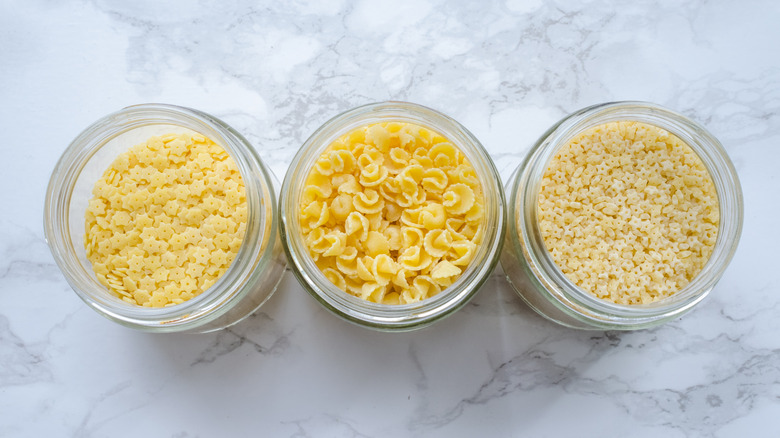Jamie Oliver's Spaghetti Hack For Making Fake Orzo In A Pinch
My family and I have become smitten with Jamie Oliver's cooking shows. He hosts several, and in each one, he creates the most gorgeous, delicious-looking recipes with ease. Whether Jamie Oliver is cooking up an overlooked cut of meat or putting grapes on pizza, his affinity to make any food enticing and his clever ingredient hacks are inspiring, to say the least. For example, his recipe for Greek-Cypriot pasta from his book "5 Ingredients Mediterranean: Simple Incredible Food" calls for orzo pasta, which is a super tiny cut that resembles rice. According to Oliver, if you can't get your hands on orzo, you can fake it by using spaghetti, a kitchen towel, and the edge of your table or kitchen counter.
Taking a small handful of dried spaghetti, Oliver lays it on a towel and rolls the fabric around the strands to create a cylindrical shape. Next, he holds both open, short ends of the towel shut. Placing the towel-wrapped pasta against the edge of the counter, he pulls downward so that the entire length of the spaghetti breaks against it. You can hear the pasta crunching as he runs the towel down from the edge. After doing this a few times, the now broken up spaghetti is roughly the size as orzo and can be used in the recipe just the same.
Despite Oliver being very well-versed in Italian cuisine, his pasta hack is actually very controversial. Many Italians and professional chefs downright shun the idea of breaking pasta; Bobby Flay even calls the practice "sacrilegious." Welp, I suppose every individual sometimes has to decide between some kind of pasta (even if it's broken) or none at all.
Good substitutes for orzo pasta
If you find yourself out of orzo pasta and don't want to break any Italian hearts (or Bobby Flay's, for that matter), there are other pasta shapes and cuts that make excellent substitutions for orzo. Orzo isn't typically so elusive that you need to seek it out at a specialty Italian grocery store or order it online, and I regularly see it at large grocery chains. However, I have also lived in places where I couldn't find the pasta cut all the time. In these instances, I would have welcomed Jamie Oliver's tip about crunching up some strands of spaghetti.
In the past, I have used other, small shapes of pasta to stand in for orzo including acini di pepe, which is a very tiny cut that almost resembles little polka dots. A pasta called pastina is just as tiny but is shaped like stars with a dot in the middle. This is the pasta shape of choice for making pastina soup, which is known as "Italian penicillin."
Ditalini look like small, short tubes of pasta, although they are much larger than acini di pepe and pastina. I have used shells (conchiglie) in place of orzo before, but you should be sure you purchase the absolute smallest shells you can find — the size that says, "don't even think about trying to stuff anything in me." In fact, if you lay a tiny pasta shell next to a grain of orzo, they are just about the same size in length. You can even use pastas from Mexican brands like La Moderna — the conchas (shells), estrellas (stars), fideos (short vermicelli), and semillas de melon (melon seeds) are all great stand-ins for orzo.

